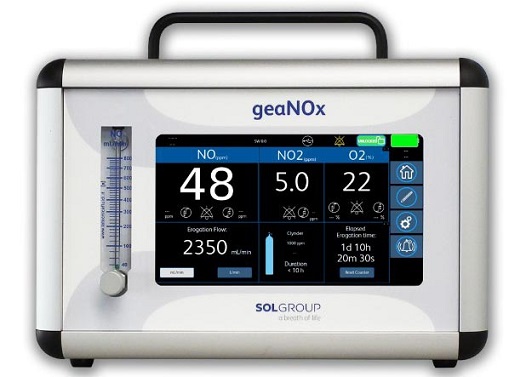Nikhil Prasad Fact checked by:Thailand Medical News Team Jul 30, 2024 8 months, 3 weeks, 6 days, 17 hours, 30 minutes ago
COVID-19 News: In the ongoing battle against COVID-19, researchers are continuously seeking effective treatments for severe cases of viral pneumonia caused by the virus. A recent study has shed light on the potential benefits of using high-dose inhaled nitric oxide (iNO) for treating adults hospitalized with viral pneumonia. This
COVID-19 News report explores the findings of this study and what it means for future treatment options.
 Inhaled nitric oxide shows promising results for COVID-19 pneumonia patients
The Study
Inhaled nitric oxide shows promising results for COVID-19 pneumonia patients
The Study
A team of researchers from various institutions in Israel, including Shaare Zedek Medical Center, Rabin Medical Center, Hebrew University of Jerusalem, Tel Aviv University, Beilinson Hospital, Beyond Air Ltd., and Ben Gurion University of the Negev, conducted a comprehensive study to evaluate the safety and efficacy of intermittent high-dose iNO. This article aims to present the study’s findings in a manner that is easy to understand for everyone.
Methodology
The study involved 40 adults aged 18 to 80 who were diagnosed with viral pneumonia and hospitalized. These patients were randomly divided into two groups: a control group that received standard supportive treatment (SST) alone, and a treatment group that received SST combined with intermittent high-dose iNO. The iNO was administered using a novel iNO-generator at a dose of 150 ppm, four times daily for up to seven days.
Key Findings
Safety Evaluation
One of the primary goals of the study was to assess the safety of high-dose iNO treatment. The results showed that the adverse events (AEs) rates were similar between the two groups, with no treatment-related adverse events reported. This indicates that high-dose iNO is well-tolerated by patients, with no significant safety concerns.
Oxygen Support Duration
A significant finding from the study was the reduction in the duration of oxygen support needed for patients in the treatment group. Patients receiving iNO treatment required oxygen support for an average of 2.7 days less than those in the control group. This reduction is a promising sign that iNO could help patients recover more quickly and reduce the burden on healthcare systems.
Oxygen Saturation
Another critical measure of the study was the patients’ oxygen saturation levels. The treatment group showed a higher likelihood of achieving stable oxygen saturation levels (≥93%) during hospitalization compared to the control group. This improvement in oxygen saturation is crucial for patients with severe pneumonia as it indicates better respiratory function and overall recovery.
Hospital Discharge
While the duration of hospital stays was not significantly different between the two groups, the treatment group showed a trend towards earlier discharge. This suggests that patients receiving iNO might recover faster and be ready to
leave the hospital sooner, although more research is needed to confirm this trend.
Mechanism of Action
Inhaled nitric oxide has been used for over 25 years as a treatment to improve arterial oxygenation in acute respiratory distress syndrome (ARDS). It works by inducing vasodilation, which helps improve blood flow and oxygenation in the lungs. Additionally, nitric oxide has antimicrobial properties that can help fight infections, including those caused by viruses.
Study Limitations
The study had some limitations, including a small sample size and early termination due to the challenging conditions of the COVID-19 pandemic. Most patients in the study had COVID-19-induced pneumonia, which might limit the generalizability of the findings to other types of viral pneumonia. Despite these limitations, the study provides valuable insights into the potential benefits of high-dose iNO treatment.
Future Implications
The positive results of this study suggest that high-dose iNO could be a valuable addition to the treatment options for viral pneumonia, particularly in severe cases caused by COVID-19. Further research with larger sample sizes and diverse patient populations is needed to confirm these findings and determine the optimal dosing and administration protocols.
The study findings were published in the peer-reviewed journal: Scientific Reports.
https://www.nature.com/articles/s41598-024-68055-w
For the latest
COVID-19 News, keep on logging to Thailand Medical News.
Read Also:
https://www.thailandmedical.news/news/covid-19-news-the-potential-of-nitric-oxide-in-the-treatment-of-covid-19
https://www.thailandmedical.news/news/covid-19-news-phase-2-randomized-clinical-trial-shows-that-high-dose-inhaled-nitric-oxide-helped-in-covid-19-acute-hypoxemic-respiratory-failure
https://www.thailandmedical.news/news/nitric-oxide-for-covid-19-study-shows-inhaled-nitric-oxide-could-be-used-as-an-adjunct-therapy-for-pregnant-covid-19-patients
